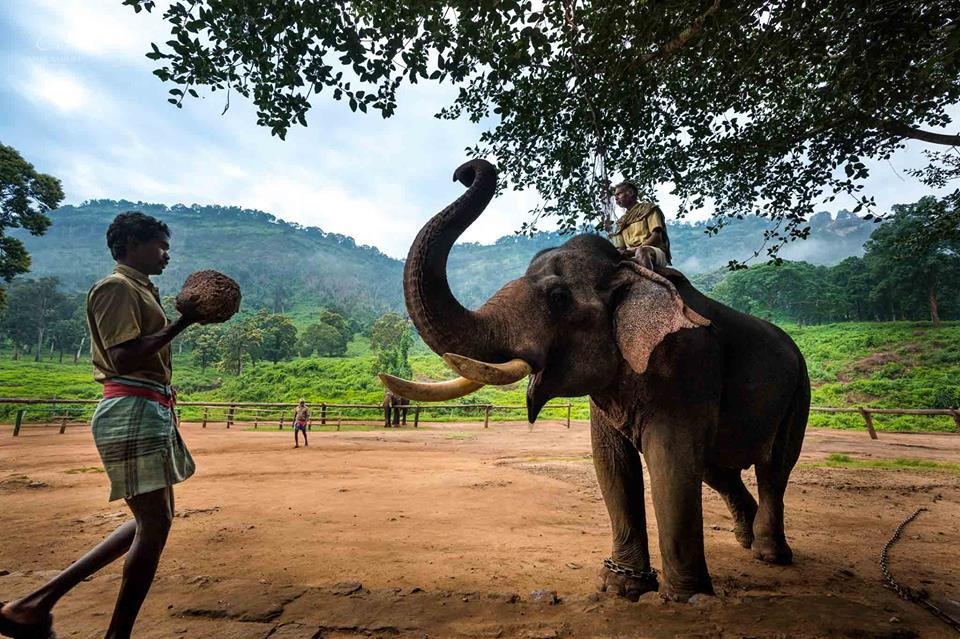The Kozhikamuthi Elephant Camp is a notable tribal settlement located in the picturesque Ulaandy range of the Anamalai Tiger Reserve, adjacent to TopSlip. This unique camp serves a vital purpose: to house and train captive elephants with the expertise of the native Malasar tribes, who possess an extensive and deep-rooted understanding of engaging with Asian elephants. The elaborate system of training and care provided at Kozhikamuthi reflects centuries of tradition and enhances the ecological balance in the region by managing wildlife interactions and mitigating human-elephant conflicts.
Unique Features of the Kozhikamuthi Elephant Camp
- Cultural Heritage: The camp is not just a facility for elephant training; it embodies a tradition that has been passed down through generations among the Malasar tribes. This community’s ancestral knowledge is crucial for maintaining the well-being of the elephants and the local ecosystem.
- Handling Conflict Situations: The elephants trained here are not only adept at being part of the camp but are also well-equipped to handle various conflict situations. They play a key role in:
- Driving away wild elephants that raid crops, thereby protecting local agriculture.
- Controlling stray elephants that might pose a threat to nearby human settlements.
- Notable Kumki Elephants: The camp is home to several renowned kumki elephants, particularly male tuskers. Noteworthy residents include:
- Kaleem: Captured from the Sathyamangalam forests in 1972, he has been instrumental in capturing over 25 wild elephants across Tamil Nadu, Andhra Pradesh, and Kerala over two decades.
- Other Tuskers: Venkatesh, Kapil Dev, and Bharani also stand out for their contributions to the camp.
- Feeding and Care Practices: In addition to professional training, daily care for the elephants is thorough and attentive:
- Daily Foraging: Elephants are allowed to roam and forage freely in the forest for about eight hours each day, allowing them to engage with their natural behaviors.
- Evening Routines: At dusk, the mahouts guide the elephants back to the camp, where they receive a warm bath from their cavadies (assistants). This bonding time fosters trust and comfort.
- Nutritional Diet: The elephants are fed a specialized diet comprising ragi, horse gram, salt, and jaggery, with feeding often taking place before onlookers, which showcases the intricate relationship between the elephants and their caretakers.
- Challenges Facing the Camp: Despite the rich heritage and ecological benefits provided by the camp, there are emerging challenges that threaten its future:
- Decline of Mahouts: Many mahouts express a desire for their children to pursue careers in urban settings rather than continuing the family tradition. This trend raises concerns about a potential shortage of skilled mahouts in the future.
- Preservation of Traditions: The shift in aspirations may endanger traditional practices and experiences essential for the well-being of the elephants and the preservation of cultural wisdom.
The Kozhikamuthi Elephant Camp is not merely a facility for elephant training; it is a living testament to the harmonious relationship between humans and nature. The camp plays an essential role in managing human-elephant conflicts while serving as a critical training ground for these magnificent creatures. However, the future of the camp hangs in the balance as the younger generation explores opportunities beyond their ancestral roots. As we engage more deeply with the preservation of both culture and biodiversity, it becomes crucial to recognize and support the efforts that the Kozhikamuthi Elephant Camp embodies. It stands as a symbol of ecological balance, cultural heritage, and the poignant connections that can exist between people and wildlife
